

SDGs. History The 2030 Agenda for Sustainable Development, adopted by all United Nations Member States in 2015, provides a shared blueprint for peace and prosperity for people and the planet, now and into the future.
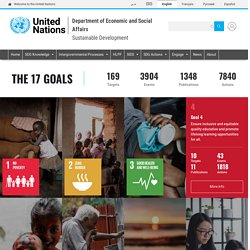
At its heart are the 17 Sustainable Development Goals (SDGs), which are an urgent call for action by all countries - developed and developing - in a global partnership. They recognize that ending poverty and other deprivations must go hand-in-hand with strategies that improve health and education, reduce inequality, and spur economic growth – all while tackling climate change and working to preserve our oceans and forests. The SDGs build on decades of work by countries and the UN, including the UN Department of Economic and Social Affairs In June 1992, at the Earth Summit in Rio de Janeiro, Brazil, more than 178 countries adopted Agenda 21, a comprehensive plan of action to build a global partnership for sustainable development to improve human lives and protect the environment.
The life cycle of a milk bottle. The Life Cycle of a Water Bottle - Infographic. Simpleshoesfinalreport. Sneaker Life Cycle Impact. The American term sneakers refers to footwear with a flexible sole made of rubber or synthetic material and an upper part made of leather or canvas.
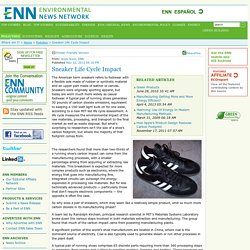
Sneakers were originally sporting apparel, but today are worn much more widely as casual footwear. A typical pair of running shoes generates 30 pounds of carbon dioxide emissions, equivalent to keeping a 100-watt light bulb on for one week, according to a new MIT-led life cycle assessment. A life cycle measures the environmental impact of the raw materials, processing, and transport to the final market as well as waste disposal. World Steel Association - Life cycle thinking. Building material Life cycle (Interesting graphs) Footprint of our products. Nokia Lumia 1520 The Nokia Lumia 1520 was our very first phone using recycled plastics in the product cover.
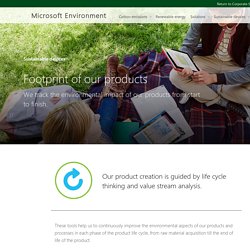
Energy use 544 MJ Greenhouse gas emissions: 37 kg CO2-eq. Energy efficiency: automatic screen brightness adjustment, battery saver feature, energy efficient charger Eco content and services: available at Store, HERE Drive: route optimization, HERE Maps: pedestrian navigation, HERE Transit: public transportation route planning Materials: Contains recycled metals in inner parts of the product & the black color variant incudes recycled plastics in the product’s cover parts.
Recycling: 100% recoverable as materials and energy Packaging: 100% recyclable, minimized package made of renewable materials containing up to 80% recycled materials and the virgin wood fibers are up to 100% certified. Mobile Phone Life Cycle. Untitled. Understanding the origin of products is key to ending supply chain scandals. There are many business benefits to knowing the origin of a product and understanding how raw materials are turned into finished goods.

However, in reality few companies have access to detailed, accurate and verified information, and the return on investment for gaining this knowledge is poorly understood. There can be thousands of global suppliers in complex value chains, but there may be no single department with responsibility for traceability. However, this can change. There are compelling business cases for companies to map their value chains. Increased income Information on the origin of products has been used to increase value for centuries. The global market for food traceability technology is predicted to grow by 8.7% annually for the rest of the decade and be worth $14.1bn by 2020. Decreased costs Market price typically relates to availability.
In the textiles industry, fabric is frequently dyed to a specific colour by a contracted dye-house. Control risks. Consumer behaviour and sustainability - what you need to know. 1.
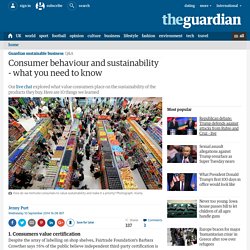
Consumers value certification Despite the array of labelling on shop shelves, Fairtrade Foundation’s Barbara Crowther says 76% of the public believe independent third-party certification is the best way to verify a product’s social or environmental claims. However, according to Lucy Atkinson, an assistant professor at the University of Texas, while the trust of US consumers lies in government or third-party labels, the appeal of a company doing good is found in a brand’s own labelling. Could there be the need for a collaborative approach with a joint labelling scheme, asks Atkinson, or even standardised metrics based on specific concerns such as worker rights or environment, suggests reader, Eleanor Mc. 2.
Sustainable Supply Chains: Can Retailers Be the Rising Tide That Lifts All Boats? Target uses its own Sustainable Product Standard to communicate its priorities for its personal care and household cleaning products.

The company evaluates chemicals of concern, ingredient transparency and environmental impact for items in these categories. | Image credit: Refinery 29 A whopping 97 percent of environmental impacts in the retail sector come from the product itself — from raw materials, transportation and product manufacturing. With impacts so heavily weighted in the supply chain, retailers are increasingly and creatively wading upstream to partner with their suppliers on their greatest impacts. The key to success lies in selecting the appropriate supplier engagement method and then using that approach as a vehicle to deeper collaboration. But can successful retailer approaches truly motivate meaningful supply chain improvements?
The benefits of engagement Product category surveys. Sustainability Skills – Life cycle analysis. Product improvement and life cycle analysis. Consumers are becoming more concerned about sustainability and more knowledgeable about environmentally friendly products.
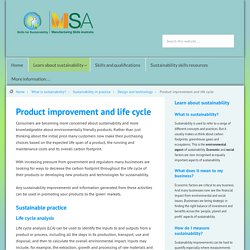
Rather than just thinking about the initial price many customers now make their purchasing choices based on the expected life span of a product, the running and maintenance costs and its overall carbon footprint. With increasing pressure from government and regulators many businesses are looking for ways to decrease the carbon footprint throughout the life cycle of their products or developing new products and technologies for sustainability.
Any sustainability improvements and information generated from these activities can be used in promoting your products to the ‘green’ markets. Sustainable practice. Life cycle of a consumer product : Water Resources. Extension > Environment > Water Resources > Life cycle of a consumer product Shirley L.
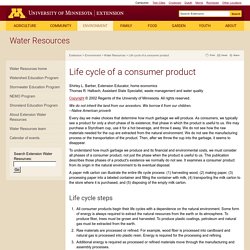
Barber, Extension Educator, home economics Thomas R. Halbach, Assistant State Specialist, waste management and water quality Copyright © 2002 Regents of the University of Minnesota. All rights reserved. We do not inherit the land from our ancestors.